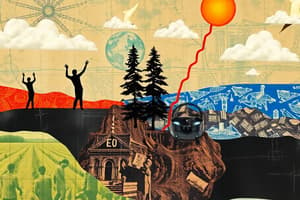Podcast
Questions and Answers
What is the latitude of the subsolar point also known as?
What is the latitude of the subsolar point also known as?
- Solar altitude
- Solar declination (correct)
- Circle of illumination
- Tropic of Cancer
Which layer of the atmosphere is known for containing 80% of the atmosphere's mass?
Which layer of the atmosphere is known for containing 80% of the atmosphere's mass?
- Thermosphere
- Troposphere (correct)
- Stratosphere
- Mesosphere
What occurs as a result of the changing solar altitude and length of daylight hours?
What occurs as a result of the changing solar altitude and length of daylight hours?
- Greenhouse effect
- Earth’s seasonality (correct)
- Atmospheric absorption
- Air pressure dynamics
What is the term for the line that separates day from night?
What is the term for the line that separates day from night?
What phenomenon keeps Earth's average temperature higher than it would be if Earth was a blackbody?
What phenomenon keeps Earth's average temperature higher than it would be if Earth was a blackbody?
How does air density change with height in the atmosphere?
How does air density change with height in the atmosphere?
What primarily comprises the troposphere?
What primarily comprises the troposphere?
What is atmospheric absorption?
What is atmospheric absorption?
What is the primary function of a forest in environmental systems?
What is the primary function of a forest in environmental systems?
Which type of feedback in environmental systems tends to amplify disturbances?
Which type of feedback in environmental systems tends to amplify disturbances?
What signifies a stable state in an ecological system?
What signifies a stable state in an ecological system?
Which of the following describes a dynamic equilibrium in environmental systems?
Which of the following describes a dynamic equilibrium in environmental systems?
What happens when a climate tipping point is reached?
What happens when a climate tipping point is reached?
Which statement describes the current state of the Earth system?
Which statement describes the current state of the Earth system?
How do anthropogenic activities affect ecological systems?
How do anthropogenic activities affect ecological systems?
What does the ice-albedo feedback mechanism illustrate?
What does the ice-albedo feedback mechanism illustrate?
What is the solar constant, and what does it represent?
What is the solar constant, and what does it represent?
Which effect explains why the Earth receives different amounts of solar radiation at various latitudes?
Which effect explains why the Earth receives different amounts of solar radiation at various latitudes?
Which statement regarding hot and cold objects is correct?
Which statement regarding hot and cold objects is correct?
What is the primary reason for variations in insolation throughout the year?
What is the primary reason for variations in insolation throughout the year?
What process uses photosynthetically active radiation (PAR)?
What process uses photosynthetically active radiation (PAR)?
How does the concept of 'sphericity of the Earth' affect insolation?
How does the concept of 'sphericity of the Earth' affect insolation?
What role does the subsolar point play in solar energy distribution?
What role does the subsolar point play in solar energy distribution?
What is the primary characteristic of terrestrial longwave radiation emitted by Earth?
What is the primary characteristic of terrestrial longwave radiation emitted by Earth?
What is the main effect of deforestation on interception?
What is the main effect of deforestation on interception?
How does deforestation influence transpiration rates?
How does deforestation influence transpiration rates?
What occurs when rainfall intensity exceeds infiltration capacity?
What occurs when rainfall intensity exceeds infiltration capacity?
What characterizes a gaining stream?
What characterizes a gaining stream?
What is a defining feature of the urban heat island (UHI) effect?
What is a defining feature of the urban heat island (UHI) effect?
How does urbanization typically affect runoff patterns?
How does urbanization typically affect runoff patterns?
What hydrologic effect was observed in the Hubbard Brook catchment due to deforestation?
What hydrologic effect was observed in the Hubbard Brook catchment due to deforestation?
Which statement about flow paths after deforestation is true?
Which statement about flow paths after deforestation is true?
What is one consequence of increased impervious areas in urban environments?
What is one consequence of increased impervious areas in urban environments?
How does El Niño affect global weather patterns?
How does El Niño affect global weather patterns?
What typically occurs during urbanization regarding water runoff?
What typically occurs during urbanization regarding water runoff?
What effect does decreased water availability have in urban areas?
What effect does decreased water availability have in urban areas?
What is the impact of sewerage systems on water flow in urban areas?
What is the impact of sewerage systems on water flow in urban areas?
Study Notes
Environmental Systems
- Functions: Processes within a system, like carbon storage in forests.
- Scale: Time and space dimensions impacting system behavior.
- Feedbacks: Amplification or dampening of initial disturbances within a system.
- Positive Feedback: Enhances initial change, pushing system to a new state (e.g., global warming).
- Negative Feedback: Dampens change, bringing system back to original state.
- Equilibrium States: Steady-state (inputs ≈ outputs) and dynamic equilibrium (inputs < or > outputs).
- Stable States: Dominated by negative feedback.
- Unstable States: Dominated by positive feedback.
- Equilibrium States: Can be stable or unstable, influencing system behavior.
- Climate Tipping Points: Thresholds that trigger dramatic change into a new state (e.g., permafrost thawing).
Solar Radiation and the Atmosphere
- Electromagnetic Radiation: Radiant energy emitted by objects with temperature above absolute zero.
- Shortwave Radiation: Emitted by hotter objects (e.g., Sun).
- Longwave Radiation: Emitted by cooler objects (e.g., Earth).
- Solar Constant: Average solar radiation Earth receives at its average distance from the Sun (1370 W/m²).
- Photosynthetically Active Radiation (PAR): Radiation used for photosynthesis by plants.
- Earth's Tilt: Causes seasonal variation in daylight hours and solar radiation received at different latitudes.
- Subsolar Point: Point where Sun's rays are perpendicular to Earth's surface.
- Circle of Illumination: Line separating day and night.
- Solar Altitude: Angle of the Sun above the horizon, varying from equator to poles.
- Atmospheric Transmission: Passage of shortwave and longwave radiation through the atmosphere.
- Atmospheric Scattering/Reflection: Redirection of radiation through interactions with atmospheric particles.
- Atmospheric Absorption: Absorption of radiation by atmospheric constituents, causing heating.
- Greenhouse Effect: Warming of Earth's surface due to absorption of longwave radiation by greenhouse gases in the atmosphere.
- Air Density: Amount of gas molecules in a given volume, decreasing exponentially with height.
- Air Pressure: Weight of the atmosphere above a point, decreasing exponentially with height.
Atmospheric Layers
- Troposphere: Lowest layer of the atmosphere, where all weather occurs.
- Contains 80% of the atmosphere's mass.
- Highest water vapor content and aerosol concentration.
- Environmental Lapse Rate: Rate of cooling with increasing altitude in the troposphere.
Deforestation & Hydrology
- Deforestation significantly impacts hydrology and microclimate.
- Hydrological Effects:
- Reduced interception: More water reaches the soil surface.
- Reduced transpiration: Fewer trees, leading to lower transpiration rates.
- Increased runoff: More water flowing off the land surface.
- Microclimate Effects:
- Higher temperatures due to reduced evapotranspiration and increased solar radiation absorption.
- Altered wind patterns, influencing cloud formation.
- Creation of urban heat islands.
Urban Heat Island Effect (UHI)
- Urban areas experience higher temperatures than surrounding rural areas.
- Causes:
- Reduced evapotranspiration.
- Increased heat absorption by impervious surfaces (e.g., roads, buildings).
- Urban energy balance equation reflects these factors.
Urbanization and Hydrology
- Urbanization alters hydrological processes:
- Increased impervious areas (roads, buildings) lead to overland flow.
- Sewer systems increase subsurface flow and lower the water table.
- These changes result in:
- Increased peak runoff (floods).
- Decreased low flow runoff.
- Creation of urban rivers.
- Faster discharge (response) peaking earlier.
El Niño
- El Niño is a climate pattern characterized by warmer-than-average sea surface temperatures in the central and eastern Pacific Ocean.
- Causes:
- Reversal of trade wind patterns.
- Reduced upwelling of cold water.
- Impacts:
- Altered rainfall patterns in the tropics, leading to increased risks of floods.
- Changes in atmospheric circulation affecting weather patterns worldwide.
Studying That Suits You
Use AI to generate personalized quizzes and flashcards to suit your learning preferences.
Related Documents
Description
Explore the intricate functions of environmental systems, including processes like carbon storage and the impacts of scale on system behavior. Understand feedback mechanisms and equilibrium states, and delve into critical climate tipping points that influence environmental dynamics.




